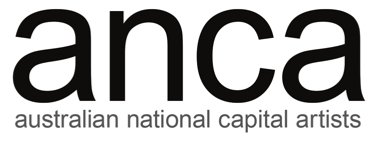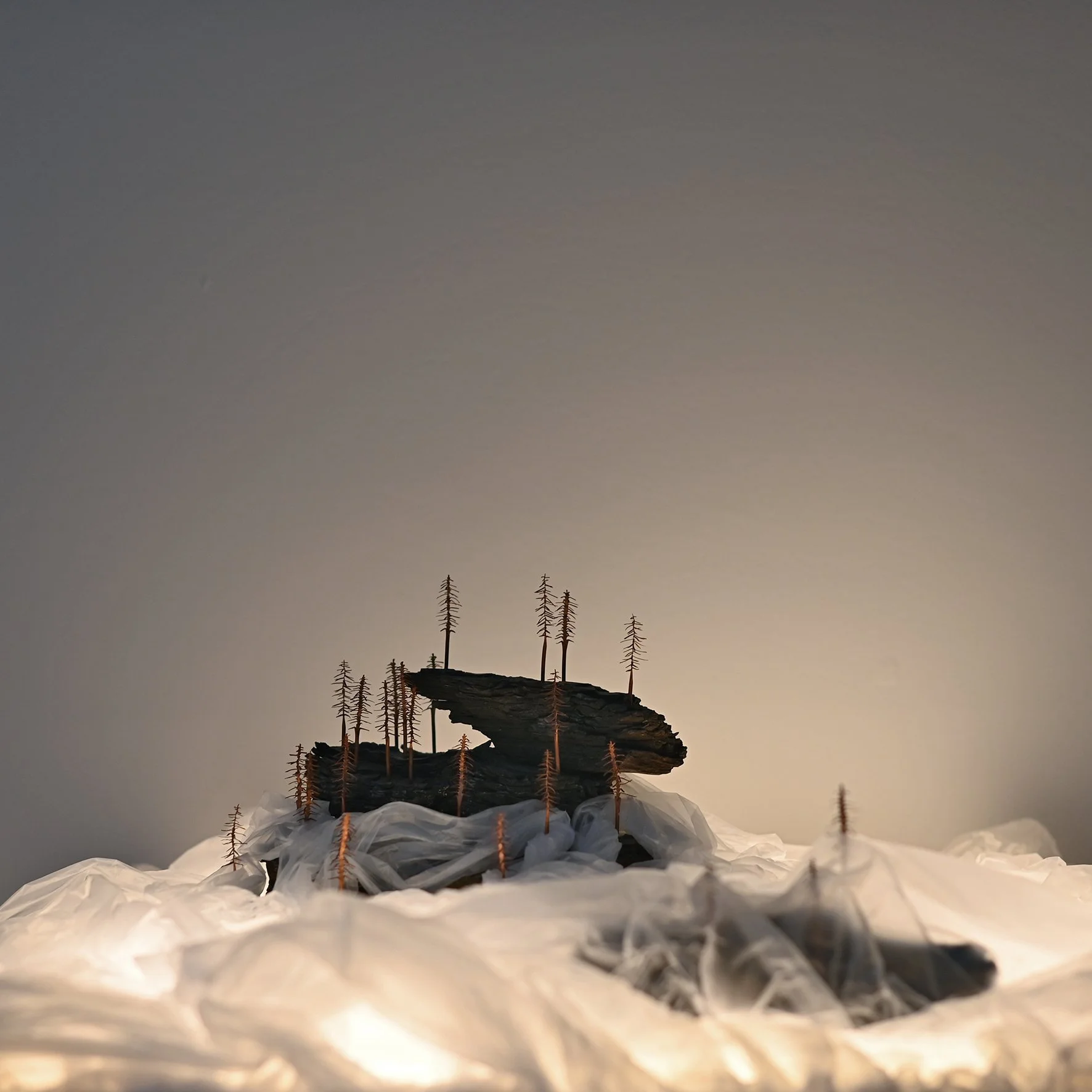Fog series, 2021
Radiata pine bark, copper, plastic film, acrylic, LED light source, aluminium composite panel, pine
127 x 180 x 180cm
All artists respond to their surroundings in an engagement that requires a particular sensitivity. Lan Nguyen-hoan’s practice centres around worldbuilding, crafting environments that are underscored by narrative. She calls these ‘landscapes of the mind’, where the internal scenes are informed by her experiences of navigating the world.
Over the challenging past two years, with events that have interrupted routines and filled days with looming uncertainty, Nguyen-hoan explored the idea of fog, a dense weather condition that obscures and disorients senses of time and space. Drawing parallels between the lack of clarity in this climate and her own need to ‘navigate through the fog of [her] mind,’ Nguyen-hoan sought to investigate the symbolic significance of incorporating fogs into her sculptural landscapes.
Fog (2021) is an installation of four miniature forests. The landscape, a multi-piece sculpture of woodlands, is created from stacked radiata pine bark and carefully hammered copper. Plastic film wraps around these forests, concealing some copper trees and pine grounds. The use of plastic – a material that envelopes and suffocates – is direct visualisation of a fog’s ominous presence, and also covers the light box that the work is displayed on. Arranged all together in a square cross or positioned separately, the four light boxes illuminate Fog from underneath and highlight the plastic film’s subtle opacity.
Fog part i: where on the side on a mountain/we’re on the side of a mountain (detail), 2021
Radiata pine bark, copper, plastic film, acrylic, LED light source, aluminium composite panel, pine
127 x 60 x 60cm
Fog part iii: invisible river (detail), 2021
Radiata pine bark, copper, plastic film, acrylic, LED light source, aluminium composite panel, pine
125 x 60 x 60cm
As a project, Fog developed tentatively for over a year and required several pauses in between before it came to be resolved. Nguyen-hoan is candid about her ongoing struggles with mental health, and has used the fog to describe her paralysing experiences: ‘Metaphorically, not only has my path been obscured but also everything around me is no [sic] longer visible – as though I'm surrounded by fog. How does one move forward without any sense of direction or spatial/environmental reference?’
The subtitles for each of the four works in Fog emphasise this sentiment of being lost: ‘a bridge from nowhere to nowhere’, ‘the unknowable peak of wisdom’, and of not being able to see, ‘invisible river’, ‘where on the side on a mountain/we’re on the side of a mountain’.
Fortunately, fog is something that clears up, often dissipating with daylight. Nguyen-hoan’s feelings of disorientation and uncertainty also lessened eventually, encouraging her to create a second series, Vessel for illumination (2021), with objects that ‘counter the fog.’
Vessel for illumination consists of three small-scale sculptures that feature other natural materials: a pinecone, a rock, and a stick. Directly subtitled as such, the materials of the works in this series are not obscured by another element. Instead, they are accentuated as they prop up from a candleholder, supported by bespoke brass stands in a colour that matches the gold foil lining the holder. The pinecone, rock, and stick are illuminated in this way by the reflective, lustrous metals. Their form as individual objects is further characterised by the delicate detail of additional copper, titanium, and brass ornamentation on them.
Vessel for illumination series: a pinecone, a rock, a stick, 2021
Pinecone, rock, stick, copper, brass, titanium, second-hand candleholders
Dimensions of all three in a row: 18 x 38 x 9cm
To Nguyen-hoan, these vessels symbolise a tool that can assist in ‘illuminating [her] way through the fog,’ a conceptual link she draws to her landscapes in the Fog installation, and a connection she reveals through a short story that accompanies both series. The fictional piece follows a character named Autumn, as she makes her way through an ‘encumbering fog’ by crouching down and ‘using her hands to see’. In this position to ‘[feel] her way along the forest floor’, Autumn collects sticks, rocks, pinecones, and other ‘forest items’ to help orient herself. While the parallels between this story, Nguyen-hoan’s personal experiences, and the work that she has made are clear and literal, the narrative demonstrates Nguyen-hoan’s figurative approach to storytelling and to making.
Vessel for illumination three, a stick (detail), 2021
Stick, titanium, brass, second-hand candleholder
12 x 15 x 9cm
During her Ph.D. candidature (2013-19), Nguyen-hoan investigated ‘symbolic expression through landscapes made with a gold and silversmith’s sensibility.’ This sensibility has continued into Fog and Vessel for illumination with her use of metals across the series in an adorned way. Her meticulous training in gold and silversmithing has given her the skill to look at everything as a malleable material and explains her tendency to work in smaller, more intimate scales.
Nguyen-hoan also cites the field of architecture as a great influence, having studied it for two years after high school. When asked why she is drawn to creating landscapes, she references the knowledge and skills she acquired during that time, which informed her practice of considering a person’s experience within their spatial environment on varying scales. Working on a micro level, Nguyen-hoan wants viewers to experience her landscapes from within, ‘as though scale was inconsequential’. To achieve this, she began experimenting with macro photography, making close-up documentation of small details in Fog. Captured from the ground plane, the images have a shallow depth of field that conversely, make the fog in the blurred background more prominent and peculiar, with a stage-like, suspenseful quality.
Tree atop the unknowable peak of wisdom, 2022
Digital photograph with focus stacking
‘A landscape presents a scene – a place for something to occur,’ Nguyen-hoan has stated. Her recent exploration in macro photography exemplifies this, offering another space for imagined experiences within her worlds.
Annette An-Jen Liu is a Taiwanese early career curator and writer. She is an alumna of ANU School of Art & Design and the University of Sydney. Liu was one of three 2020 ANCA Critic-in-Residence (CiR). The CiR is a partnership program between Art Monthly Australasia and ANCA.
Instagram: @annetteliu






